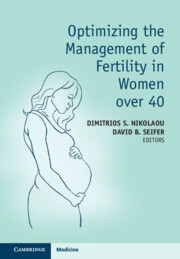Book contents
- Optimizing the Management of Fertility in Women over 40
- Optimizing the Management of Fertility in Women over 40
- Copyright page
- Dedication
- Contents
- Contributors
- Introduction
- Section 1 Demographic Trends
- Section 2 Biological Basis of Female Reproductive Aging: What Happens to the Ovaries and the Uterus as they Age?
- Section 3 Lifestyle, Environment, and Optimizing Reproduction in the 40s
- Section 4 Rethinking and Redefining “Family Planning” for the Twenty-First Century
- Section 5 Optimal Deployment of ART beyond 40
- Chapter 6 When to Use ART beyond 40: How Often, How Many Attempts, When to Stop
- Chapter 7 Optimal IVF Protocols for Women over 40 and Low Functional Ovarian Reserve
- Chapter 8 Fertility Counseling beyond 40
- Chapter 9 Support Systems and Patient Experience Architecture for Fertility Care of Women over 40 in the 2020s
- Section 6 Obstetric Management beyond 40
- Section 7 Children of Older Parents
- Section 8 What Are Realistic Alternatives to Conceiving with Autologous Eggs?
- Section 9 New Technologies
- Section 10 Ethics
- Index
- References
Chapter 6 - When to Use ART beyond 40: How Often, How Many Attempts, When to Stop
from Section 5 - Optimal Deployment of ART beyond 40
Published online by Cambridge University Press: 15 September 2022
- Optimizing the Management of Fertility in Women over 40
- Optimizing the Management of Fertility in Women over 40
- Copyright page
- Dedication
- Contents
- Contributors
- Introduction
- Section 1 Demographic Trends
- Section 2 Biological Basis of Female Reproductive Aging: What Happens to the Ovaries and the Uterus as they Age?
- Section 3 Lifestyle, Environment, and Optimizing Reproduction in the 40s
- Section 4 Rethinking and Redefining “Family Planning” for the Twenty-First Century
- Section 5 Optimal Deployment of ART beyond 40
- Chapter 6 When to Use ART beyond 40: How Often, How Many Attempts, When to Stop
- Chapter 7 Optimal IVF Protocols for Women over 40 and Low Functional Ovarian Reserve
- Chapter 8 Fertility Counseling beyond 40
- Chapter 9 Support Systems and Patient Experience Architecture for Fertility Care of Women over 40 in the 2020s
- Section 6 Obstetric Management beyond 40
- Section 7 Children of Older Parents
- Section 8 What Are Realistic Alternatives to Conceiving with Autologous Eggs?
- Section 9 New Technologies
- Section 10 Ethics
- Index
- References
Summary
ART in women over 40 years of age is a fundamentally complex undertaking fraught with many challenges. This chapter carefully reviews the data for effective ovarian reserve assessment and preconception counseling. For women undergoing IVF, we discuss the evidence base for the different stimulation regimens and the multitude of adjunctive treatments proposed for poor responders. Finally, we discuss expected treatment success and when to consider stopping further IVF attempts with autologous oocytes.
- Type
- Chapter
- Information
- Optimizing the Management of Fertility in Women over 40 , pp. 71 - 80Publisher: Cambridge University PressPrint publication year: 2022



